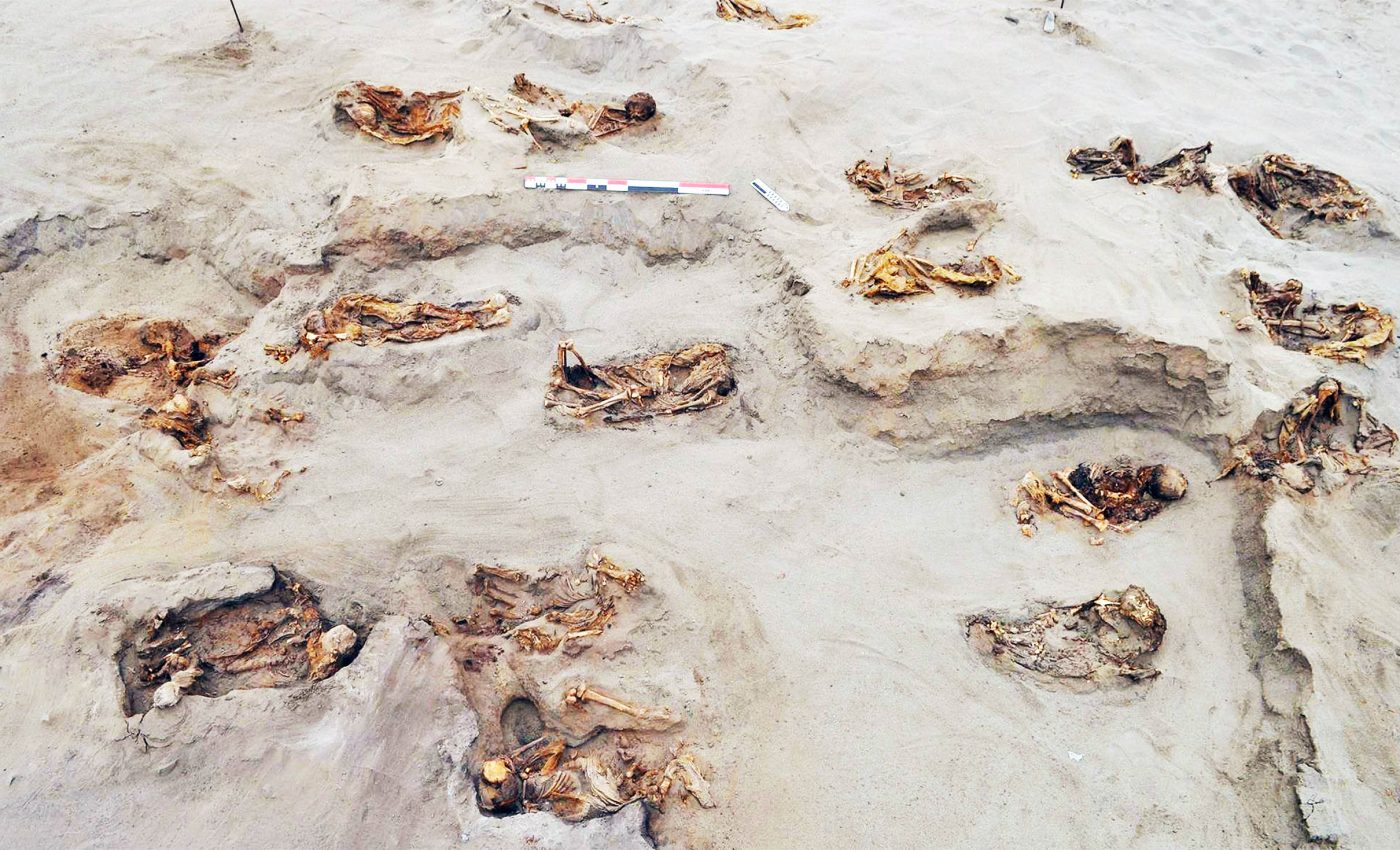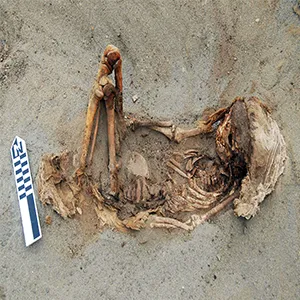
140 child sacrifice victims were killed at the same time to 'appease the gods for harvest'
A sandy bluff on Peru’s north coast holds a scene that stops you cold. In hardened mud, faint footprints – some tiny made by barefoot children, others made by adults wearing sandals – lead into a tight patch of ground near the shore.
Beneath that surface, researchers uncovered the remains of more than 140 children and over 200 young camelids, all placed there during one organized ritualistic sacrifice event around AD 1450.
The site is called Huanchaquito-Las Llamas, just outside the ancient capital of the Chimú state. It’s a layered, disturbing record that shows how a powerful society responded when severe weather disrupted daily life.
Archaeologists from the Universidad Nacional de Trujillo and University of Tulane, working at Huanchaquito-Las Llamas, combined field excavation with laboratory analyses to reach these conclusions.
Their approach follows standard methods in Andean archaeology, but the scale and clarity of this assemblage make the case unusually strong.
One child sacrifice event, not many
Archaeologists traced the site’s stratigraphy like pages in a book. The children and camelids lay in the same clean sand layer at nearly the same depth, with no burial pits cutting into earlier burials.
Footprints pressed into wet mud – later dried and covered by sand – run across the area within the same horizon.
Radiocarbon dates from plant material cluster in the mid-1400s, pointing to a single, centrally planned ritual rather than scattered acts over years.
That wet mud matters. On this coast, El Niño events can dump torrents onto an otherwise dry landscape. Floods turn firm paths into muck, collapse canals, and wreck fields.
The preserved mud layer, paired with the footprints, ties the sacrifice to one such flood episode. Around AD 1450, the state appears to have acted during a moment of crisis.
Identifying the child sacrifices
Osteologists estimate that most were between eight and fourteen years old, using dental development and bone growth markers. DNA results show both boys and girls were present.
Many skulls carry deliberate head shaping – some rounder, some flatter at the back – styles that varied across ancient Andean communities.
Chemical “fingerprints” in teeth point to multiple regions within Chimú control, not a single hometown.
Diet clues line up with life on this coast. Carbon and nitrogen isotopes in tooth dentin show a mix of C3 and C4 plants – beans and maize – plus proteins mainly from land animals rather than the ocean.
Skeletal indicators do not show widespread sickness or starvation. These appear to have been healthy children from everyday households across the state.

How their lives were taken
Careful lab work shows a consistent method. Many chests were opened. On the still-fusing breastbone pieces (sternebrae), researchers recorded clean, single cuts – precise slices made by skilled hands.
Ribs often splayed outward as if the chest was forcibly opened. The pattern repeats across the assemblage.
The camelid remains show the same pattern. Their sternums and ribs bear clean cuts, with occasional signs of throat slashing or blunt force to the head.
Most were very young – many less than nine months old – with wool colors ranging from light beige to dark brown.
Children and camelids appear to have been selected and treated in parallel, likely to offer vital parts – heart or blood – to powers believed to govern rain and order.
Ancient leaders and the weather
The Chimú built their authority on irrigation systems that tamed a desert coast. When heavy rains damage canals and wash out fields, leaders lose more than crops- they risk losing legitimacy.
The mud horizon and clustered dates fit a plain truth of this region: El Niño can rapidly disrupt society. In that window, the state scaled a ritual to match the emergency it faced.
Jars in the ground
Two ceramic jars and wooden paddles turned up near the northern edge of the sacrificial area. In Chimú art and at other sites, similar paddles stir large vats of chicha, a maize beer brewed for ceremonies.
One jar, modeled with a human face and Spondylus shells – a high-status ritual marker in the Andes – appears to have been ritually broken.
These finds suggest the “before” moments: gathering, brewing, pouring, then were buried within a space of roughly 700 square meters (about 7,535 square feet).
Footprints matter here too. Tiny barefoot impressions mingle with adult sandal prints across the same slick mud surface. They read like a short, tragic procession frozen by chance and then sealed by shifting sand.
Lessons from child sacrifice rituals
Taken together, the evidence uncovered at Huanchaquito-Las Llamas marks the largest known child and camelid sacrifice in the Americas around AD 1450.
The synchronized burial layer, footprints in flood mud, clustered radiocarbon dates, standardized cut marks, and ritual equipment all point to a single centrally organized ceremony.
Children came from across Chimú territory, and the chosen camelids were young and varied in color, signaling deliberate choices at every turn.
The picture is stark, but the science is straightforward. Dating methods establish timing. Stratigraphy demonstrates sequence. Isotopes sketch diet and origin.
Bone analysis documents technique. Each line adds context to a decision made when everything felt out of control.
Weather shocks do not just hit crops; they strain systems of belief and power. This site records leaders turning to the strongest ritual within their worldview when floods threatened the foundations of daily life.
The ground at Huanchaquito-Las Llamas preserves that choice in footprints, bones, and jars – evidence as plain as a diary entry written in sand and mud.
The full study was published in the journal PLoS One.
—–
Like what you read? Subscribe to our newsletter for engaging articles, exclusive content, and the latest updates.
Check us out on EarthSnap, a free app brought to you by Eric Ralls and Earth.com.
—–













